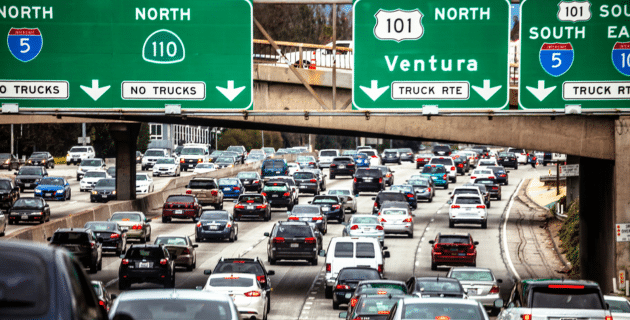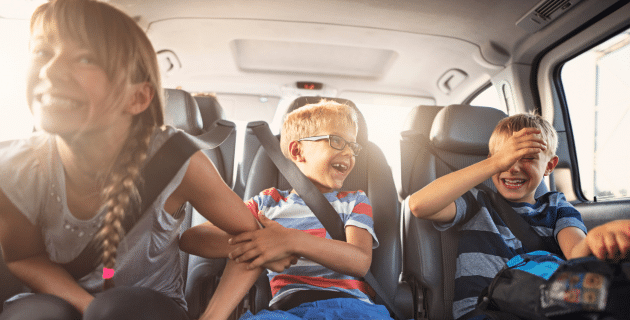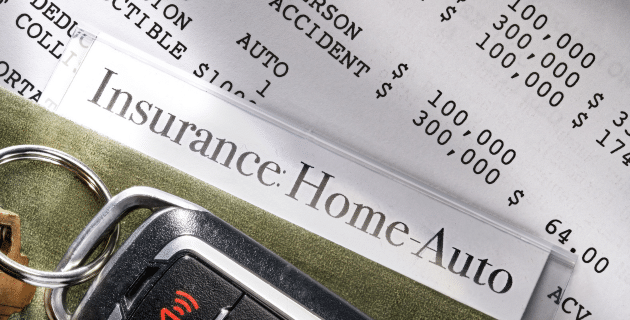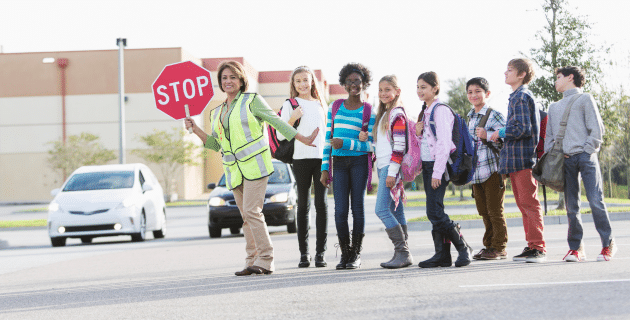
by California Casualty | Auto Insurance Info |
Buying your first car is a right of passage. Getting your first auto insurance policy is one, too. Whether you’ve graduated from your parents’ policy, just moved out, or purchased your first car, here’s what you need to know about getting that important first policy.
Learn about the types of coverages.
An auto policy is made up of different coverages. You choose the types you need from a range of options. Some coverages are required by law. Others are optional but will help to fully protect your investment.
- Liability: If you are at fault in an accident, and others are involved, it’s good to have liability coverage. Liability coverage is required by law in most states. It covers you for bodily injury and property damage you cause to others. However, it does not cover any damage to your own vehicle; that’s covered by collision. It also does not cover injury to you and your family; it only covers the people in the other car.
- Collision: This coverage is if your car is damaged in a collision with another car or an object, such as a fence. Your collision coverage will pay for repairs minus the deductible. Collision coverage is not required unless you’re leasing a car or paying off a loan on a vehicle. However, it may be good to have, especially in the event of an accident.
- Comprehensive: Comprehensive coverage is for natural disasters, fires, vandalism, theft and animals that damage your vehicle. Think of it as “bad luck coverage.” Comprehensive coverage is not usually required unless you’re leasing a vehicle or paying a car loan. However, it’s valuable to protect your car.
- Medical expenses: If you or others are hurt in an accident, you will want medical expenses covered. You will either be able to get medical payments coverage or personal injury protection (PIP). These coverages apply to everyone in your car whether or not you are at fault in the accident. This type of coverage is good to have, as your health insurance may not cover auto accidents and does not normally protect your passengers. PIP is only available in some states and may be mandatory if your state offers it.
- Uninsured or underinsured motorist: You may encounter drivers who are not insured or who are underinsured. If so, you will need insurance to cover your car and the people in your car if hit by an at-fault driver in that situation. Uninsured/Underinsured Motorist Property Damage (UMPD) helps pay for repairs to your vehicle. Uninsured/Underinsured Bodily Injury coverage pays for medical treatment, lost wages, pain and suffering for you and your passengers. These are optional coverages in most states. In some states, you are not allowed to carry collision and UMPD at the same time. Also, sometimes UMPD has a policy maximum, or cap on the amount it will pay.
See our infographic for a quick overview of car insurance, or consult our blog on liability, collision and comprehensive coverage for more detail on these coverages.
Know what affects your car insurance premiums.
Your car insurance premium will be determined by the coverages you select and other factors that contribute to the risk you present as a driver. These include, but are not limited to:
- Where you live: If you live in the city, there’s greater risk for vandalism and theft. If you live in a location prone to floods, wildfires or other disasters, you could pay more as well. You don’t necessarily have to move to get better rates, but sometimes moving into a neighboring zip code can save you some money.
- How often you drive: The more you drive, the greater chances you have to get into an accident—even if you’re a safe driver. So, people who only drive their car for leisure will pay less than others with a long commute.
- Your car’s make and model: Generally, cars that are more expensive will cost more to replace; therefore, it will cost more to insure them. Cars that are highly rated for safety, or that include certain safety features, may qualify for a reduction in your premium.
- Your driving record: Insurance companies use your past behavior to predict your future behavior. That’s why drivers with few or no accidents, and few or no moving violations like speeding tickets, pay less than those with lots of claims. In many cases, companies keep the violations on record for 3 years. If you have a clean driving record otherwise, you may qualify for a lower rate.
Tips to Save Money on Your Policy
- Shop around. You’ll pay more as a first-time driver and so it’s always good to compare pricing. Compare quotes for insurance but be sure that you are looking at similar coverages or it won’t be a fair comparison.
- Raise your deductible. Since the deductible is the amount your insurance provider will subtract from an insurance payout, you’ll want to select a deductible that you’re comfortable paying out-of-pocket after a loss. However, if you can afford to raise the deductible, you could lower your premium.
- Reduce your annual mileage. Consider carpooling or taking public transportation to reduce your mileage, which in turn can reduce your premium. In most states, your insurer pulls reports to determine annual mileage. But your daily commute mileage to work each day can impact rates so it’s a good idea to live close to where you work.
- Ask about discounts. You may get a discount for installing an anti-theft device. You may qualify for affinity or association member group discounts. At California Casualty, we offer special group rates for educators, nurses, and public safety employees.
- Maintain a good insurance score. This score, known as the Financial Responsibility (FR) Score, is allowed in most states, and has a big impact on your premiums.
Insurance companies use the same basic information to determine your rate. At California Casualty, we have our own unique formula to help our clients save money. Learn more by getting a free quote at https://mycalcas.com/quote.
This article is furnished by California Casualty, providing auto and home insurance to educators, law enforcement officers, firefighters, and nurses. Get a quote at 1.866.704.8614 or www.calcas.com.

by California Casualty | Auto Insurance Info, Safety, Travel |
We’ve all had that uncomfortable feeling of being tailgated. It’s not just an annoyance. It’s a dangerous behavior that can lead to an accident. But just how risky is tailgating and what can we do about it? Read on.
What is tailgating?
When you’re too close to the car in front of you, you’re riding “on its tail,” or tailgating. Tailgating is an aggressive behavior that can be mistaken for road rage, and even lead to it. Interestingly, even though drivers who tailgate seem to rush ahead, tailgating has little effect on getting there faster.
Why do people tailgate?
There are many reasons why people tailgate. Here are a few of the most common ones.
- Aggressive drivers tend to tailgate. These are the same folks who speed and cut it close when making lane changes. They also can quickly escalate into road rage episodes.
- Drivers who are impatient or frustrated may tailgate. They’re in a hurry and they want to get past the traffic to their destination.
- Intoxicated or drowsy drivers may tailgate without realizing it. Their state of mind causes them to misjudge the distance to the car in front of them.
- Young drivers sometimes tailgate. They do not fully understand the safe distance between cars and/or the consequences of this risky behavior.
- Distracted drivers may tailgate because they’re not paying attention to the road. They’re on their phones or fiddling with something in the car.
Almost always, drivers who tailgate have a false sense of security. They think they can stop in time. Yet it may take longer than you think. Stopping distance is directly related to the size and weight of your vehicle. A large truck will take much longer to stop than a small car. Sharing the road with vehicles of all sizes is important. You need to give yourself an adequate cushion of safety so you have enough time to react and stop your vehicle.
What are the effects of tailgating?
At the very least, you can make the driver in front of you nervous by tailgating. You may even cause them to drive too fast or shift lanes quickly which can cause an accident. They also may tap on their brakes to tell you to back off. That can trigger an accident or road rage incident. In a worst-case scenario, they can stop short, causing you to rear-end them. You may even cause a chain reaction of rear-end collisions.
Rear-end collisions make up about 23% of all crashes, according to the National Highway Traffic Safety Administration (NHTSA). These types of collisions cause approximately 950,000 injuries and 2,000 deaths each year.
Who is liable for a tailgating accident?
In nearly all cases, the driver who is tailgating is the person at fault in a rear-end collision. Note that a single at-fault accident could raise your insurance premium.
Learn the 3-second Rule.
If you’re alert and focused on the road, it takes you about 2 seconds to react to a roadway hazard. That means a safe following distance is at least 3 seconds or more.
Use the 3-second rule as a starting point. You can measure the distance in seconds this way:
- Find a landmark such as a mile marker or telephone pole.
- Start counting once the car in front of you passes that landmark.
- Count slowly until your car reaches the same landmark.
- That is the number of seconds that you are traveling behind the vehicle in front of you.
You will want to increase your following distance when the weather is bad. It’s recommended to use 4 seconds for wet weather and 10 seconds for snow and ice.
How should you react if you are being tailgated?
The last thing you want to do is to be rear-ended by a tailgater. If you are being followed too closely, you will want to take evasive action.
- Don’t engage or look at the tailgater.
- Don’t tap your brakes to tell them to back off. This can be construed as hostile and can cause the driver to react.
- Change lanes and allow the driver to pass.
- Maintain your distance from the driver. Keep as far away as possible.
- Practice defensive driving as you continue on your way.
- Be aware that your car’s crash avoidance system could cause you to brake automatically and suddenly. That may play a role in future tailgating incidents.
Your car is one of your greatest investments. Keep your car well maintained and protect it with the right insurance.
This article is furnished by California Casualty, providing auto and home insurance to educators, law enforcement officers, firefighters, and nurses. Get a quote at 1.866.704.8614 or www.calcas.com.

by California Casualty | Auto Insurance Info, Safety, Travel |
Some days it seems we’re practically living in our cars. Having the right things on hand can make our lives that much easier.
As you’re going from soccer practice to dance and back again, make sure you have the kid-friendly “must-haves” in your vehicle. In honor of Child Passenger Safety Week, we’ve also included some important items to keep everyone safe.
Essentials
Stock the basic travel items to keep everyone clean and comfortable.
- Wipes: These include wet wipes to clean hands and faces as well as disinfecting wipes for surfaces such as car seats. Up your game with stain remover wipes for those “oops” moments.
- Tissues: Travel packs are easy to store. Not only are they good for the sniffles, but they can also double as napkins after eating, or toilet paper if you’re in a bathroom that has run out.
- A towel: Dry off, clean off, or use to cover a hot seat. Towels can even double as a blanket or a napkin in a pinch.
- Scissors: These are helpful in case you need to cut a seatbelt in an emergency. In non-emergency situations, use them to cut open items that won’t easily tear.
Pro Tip: Use a laundry basket for the things going from the car into the house and back again. It’s especially useful for sports equipment.
Clothing
Keep some extra things for everyone in your family.
- Ponchos and/or umbrellas: You’ll want these for when you’re caught in the rain. You can find inexpensive disposable ponchos that do the trick.
- Extra pair of clothes: Include a change of clothes with underwear, and a plastic bag for dirty or wet things.
- Flip flops: It’s easier storing these than shoes for those times when your child splashes in muddy puddles. They’re more forgiving in size and you buy them on clearance.
- Coats, sweatshirts, and blankets: These are great when the air conditioning is blasting, or the weather turns colder unexpectedly.
Snacks and Water
Sometimes plans change, or things take longer than you expected. This way, you’ll avoid the question, “can we stop somewhere for dinner?”
- Snacks: Stock child-friendly snacks and update even nonperishable ones regularly.
- Self-serve containers: Invest in spill-proof cups and containers that enable toddlers and young children to serve themselves.
- Water: Choose reusable bottles, filled with fresh water to keep everyone hydrated. Water is also helpful when someone has sticky hands or sandy/dirty feet.
- Trash bag: You want a place where the kids can throw their trash. Disposable plastic or paper bags are good options. Make sure to empty them often.
Entertainment
Keep them occupied with their favorite activities so that you can stay focused on the road.
- Shoe box of toys: Let them decorate a shoe box and choose their favorite toys for the car. Include crayons and add some coloring books to your bag of books, below.
- Reading: Pack a bag of books for every age level. Consider audio books for longer trips.
- Power converter: Charge everything from phones to kids’ tablets to portable DVD players.
- Restaurant backpack: Stopping to eat? Fill a backpack with toys and activities for kids to use at the restaurant.
Safety
We recognize Child Passenger Safety Week each September. It’s a reminder to keep safety in mind when we’re on the road.
- LifeVac anti-choking device: Enjoying snacks in the car? This rescue suction device can save a life in a choking emergency.
- Safewise seat alarm: This device detects when you open a back door before starting the engine. It sounds a chime, then issues escalating reminders so that you won’t accidentally leave a child behind in a hot car.
- First aid kit: From band aids to antibiotic ointments, chances are you’re going to have to take care of minor injuries on the road. Make sure your first aid kit is fully stocked with the items you need. Include a first aid manual for those situations where you’re not exactly sure what to do.
- Emergency roadside kit: Make sure you’re fully prepared in case you get stuck or stranded. Flares, flashlights, and jumper cables are good things to have in your emergency car kit.
Teach your children safety in and around vehicles for added protection. Finally, protect your car with the right insurance. It will give you peace of mind as you take care of your most precious cargo—your children. Safe travels.
This article is furnished by California Casualty, providing auto and home insurance to educators, law enforcement officers, firefighters, and nurses. Get a quote at 1.866.704.8614.

by California Casualty | Auto Insurance Info, Finances, Homeowners Insurance Info |
Insurance policies may seem like they’re written in another language. Yet it’s important to understand the terms so you can get the most out of your coverage. Here’s a quick tutorial on deductibles and what they mean for your auto and home insurance.
What is a deductible?
Simply put, a deductible is the amount of money that you pay out-of-pocket before insurance kicks in. Generally, your insurer deducts the deductible amount from the payment that they make on your claim. You can find the deductible listed on the declarations page, which is the front page of your policy.
Example: If the cost of a repair is $1,500 and your deductible is $500, insurance will cover $1,000.
Unlike health insurance deductibles, you do not have to reach an annual amount in an auto or home policy before insurance will pay. Each time you file a claim, there is a deductible (if it applies). One exception is the state of Florida where hurricane deductibles are once per season.
High vs. Low Deductibles
You select your deductible from a range of choices provided by your insurer. If you choose a lower deductible, that means your insurer will need to cover more in the event of a claim, which will raise the cost of your policy. If you choose a higher deductible, you’re willing to cover more of the cost in a claim, and that will lower your premium.
Lower deductible = Higher insurance premium
Higher deductible = Lower insurance premium
It’s important to note that you will have to pay the deductible if a loss occurs in a car accident, even if you think the other driver is at fault.
You may think twice about filing a claim for a damage amount that is close to your deductible. For example, if your deductible is $1,000 and repairs are $1,250, it may not be worth it. You’d be responsible for the bulk of the repairs, and by filing a claim, your rates may go up when you renew. See our blog about when you need to file a claim and when you don’t.
Auto Policies & Deductibles
There are different types of coverage available to you for your vehicle. Some may be mandated by your state or your lender, and others are optional. Not all coverages carry a deductible.
The following coverages include a deductible, and you may choose a different deductible amount for each one:
- Collision: This coverage kicks in when you collide with another car or object.
- Comprehensive: This coverage is for damage from other causes such as hitting a deer or having a tree fall on your car.
- Uninsured motorist property damage (UMPD): This coverage is for property damage from accidents with another driver who is uninsured and at fault. UMPD may or may not have a deductible; it depends on the state and the type of loss. (Uninsured motorist coverage, which is different than UMPD, does not have a deductible.)
- Personal injury protection (PIP): This coverage pays for medical expenses regardless of who is at fault.
Pro Tip: Being able to set a deductible for each type of coverage allows you to assess the likelihood of your needing that coverage. For example, if you live in the country and might be more likely to encounter a deer than another car, you can lower the deductible for comprehensive and raise the deductible for collision.
There is auto coverage that does not carry a deductible, and that’s liability coverage. With liability coverage:
- If you are at fault: You hit another car and cause property damage and/or driver injuries. Your liability covers the damage to the other driver and his/her car without requiring a deductible. However, your own collision policy pays for damage to your car, which would come with a deductible.
- If someone else is at fault: Another driver hits your car and/or injures you. Their insurance will pay for damages and medical expenses. There are no deductibles.
Your insurer can provide quotes for different levels of deductibles and work with you to determine the best coverage for your budget.
Homeowner’s Policies and Deductibles
Whether you’re buying a new home, or you’ve owned yours for years, your homeowner’s policy protects your investment. Costs vary by location, age of home, construction type, number of bathrooms, and many other factors.
With homeowner’s insurance, there are generally three choices for deductibles:
- Flat deductibles: You would choose a fixed dollar amount, such as $1,000. That is the amount you would pay out-of-pocket before insurance kicks in.
- Percentage deductibles: You would choose percentage of your Coverage A limit. If your policy covers your home at $300,000, and you choose a 2% deductible, you would be responsible for 2% of $300,000 or $6,000.
- Peril-specific deductible option: You could have a flat deductible amount and then carry a different one specifically for wind/hail losses.
There are coverages under your home insurance that do not carry a deductible. These include Scheduled Personal Property (SPP) Coverage, Coverage E: Personal Liability, and Coverage F: Medical Payments to Others.
- Scheduled personal property (SPP) Coverage is for items that have higher values above your personal property coverage limits. This includes heirlooms, watches, jewelry, instruments, furs, or anything about which you are especially concerned such as a special guitar. (Musical instruments for example do not have a contractual limit but you will want to schedule an instrument that is special to you.) SPP offers much broader coverage for your precious items – if you lose a set of earrings, they are covered; if a diamond falls out of a ring, or if a guitar falls off a shelf and gets stepped on, they’re covered. There is no deductible if the covered items are stolen, lost, or damaged. Insurance pays the lowest of the four options: repair, replace, actual cash value or the amount of insurance.
- Personal Liability protects you if a claim is made or a suit brought against you for bodily injury or property damage caused by an occurrence to which coverage applies. These are expenses paid to third parties for their injuries and damages. Liability covers you at your place or anywhere in the world. If you are found liable, the policy will pay up to its limit of liability for damages for which an insured is legally liable. This can include medical expenses, lost wages, pain and suffering, and permanent scarring. The policy also provides a defense in court, if needed, for the policyholder. This is at the insurance company’s own expense.
Insurance may seem complicated, but it doesn’t have to be. Your agent can answer any questions you may have. Contact your insurer to find out more about protecting your most valuable possessions.
This article is furnished by California Casualty, providing auto and home insurance to educators, law enforcement officers, firefighters, and nurses. Get a quote at 1.866.704.8614 or www.calcas.com.

by California Casualty | Auto Insurance Info, Safety |
If you haven’t thought about crossing guards, school buses, and kids walking to school for a while, it’s time to refresh your memory. You’ll want to review important safety tips as everyone heads back to class.
From school zones to buses, bikes, and more, this guide shares the basics about back-to-school traffic safety. Read on to find out what you need to know.
Learn where the school zones are.
A school zone is an area on the street near a school where students typically travel on foot or by bike, skateboard, etc. It is typically located one or two blocks around the school.
- Look for signs and road markings that indicate a school zone.
- Prepare to slow down. School zones have reduced speed limits during certain hours like drop-off and dismissal.
- Watch for children, who may cross without looking. Remember that not all students use crosswalks, and not all crosswalks have crossing guards.
- Put your phone away. Texting in a school zone carries a big fine.
Be aware of the time of day.
You may drive past the school every day, but you must be extra vigilant when school is in session.
- Pay attention to when your local schools start and end the day. Know the times that students typically arrive and leave. Remember that schools sometimes have early dismissal.
- During these times, be careful backing out of driveways and traveling through the neighborhood near schools, playgrounds, and parks.
- You may even decide to take a different route to avoid the school at busy times.
Navigate school parking lots carefully.
Rushed, distracted parents and children who may not understand traffic rules create safety hazards in school parking lots. Learn and follow your school’s rules for dropping off, picking up and parking.
- Go slowly past parked cars. Children can appear out of nowhere.
- Don’t make U-turns and don’t pass a vehicle unloading passengers. These are unpredictable moves that other cars and pedestrians will not expect.
- Don’t double park as you will block the view, and ability to move, for others.
- Don’t honk your horn. You could startle those around you.
- Avoid the emergency lanes or handicap spots unless you are authorized to use them.
Know the rules for sharing the road with school buses.
It’s likely you’ll be sharing the road with school buses. These larger vehicles have their own special rules. Check your state’s laws for specifics.
- Keep a safe distance behind school buses.
- Avoid cutting in front of school buses even if your car can fit. Never pass a stopped school bus in either direction.
- Watch for yellow flashing lights that signal a bus is about to stop. By the time the bus flashes red lights, you should be stopped and that’s true for both directions.
- Be aware of a bus driver’s blind spots. They are located around the front, sides, and back of the vehicle.
Know the rules for sharing the road with bicycles.
You will likely encounter kids on bicycles as you drive. Be aware that they may or may not understand the traffic rules.
- Learn biking hand signals so you will know what a cyclist is communicating. Know that some cyclists will turn without signaling, too.
- Watch for bicycles that unexpectedly come from driveways and between parked cars.
- Allow plenty of room and slow down when you are passing a bicycle.
- Check your mirrors and blind spots before turning. Stay out of bike lanes.
- After you park your car, check your side mirrors before you open your door. That way, you hopefully won’t knock into a bicyclist with your door.
Other Safety Tips
You can be proactive to keep everyone safe during back-to-school traffic and year-round. Here are some additional tips.
- Expect the unexpected. Children are unpredictable.
- Teach your children about safety around cars.
- Teach your children how to share the road as a bicyclist and on their skateboards.
- Consider carpooling to reduce the traffic in the school parking lot.
- Give yourself extra time. When you’re not in a rush, it’s easier to make clear headed decisions.
Finally, keep your car insurance up to date for added peace of mind. After all, you’re carrying precious cargo.
This article is furnished by California Casualty, providing auto and home insurance to educators, law enforcement officers, firefighters, and nurses. Get a quote at 1.866.704.8614 or www.calcas.com.





